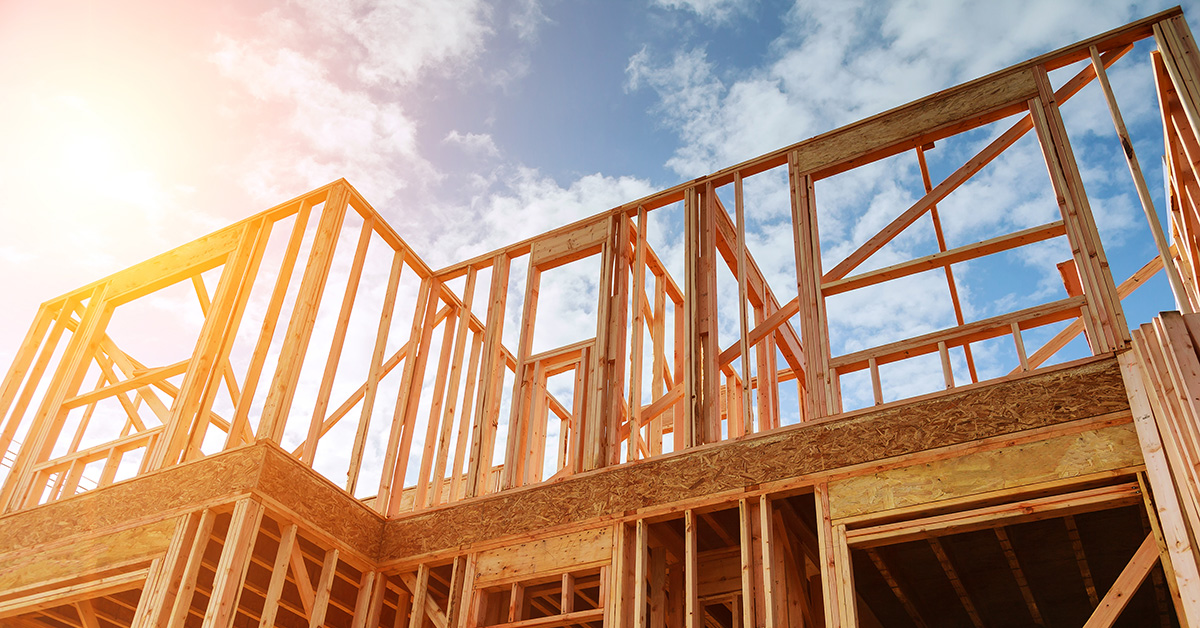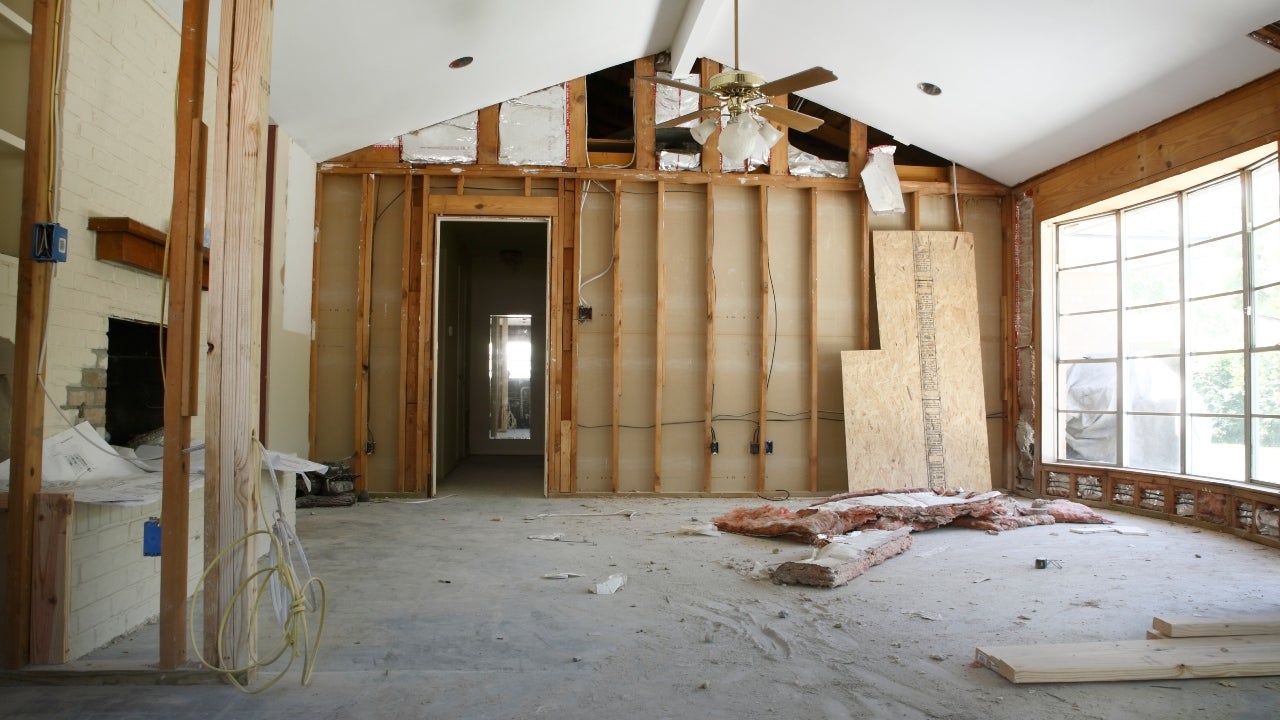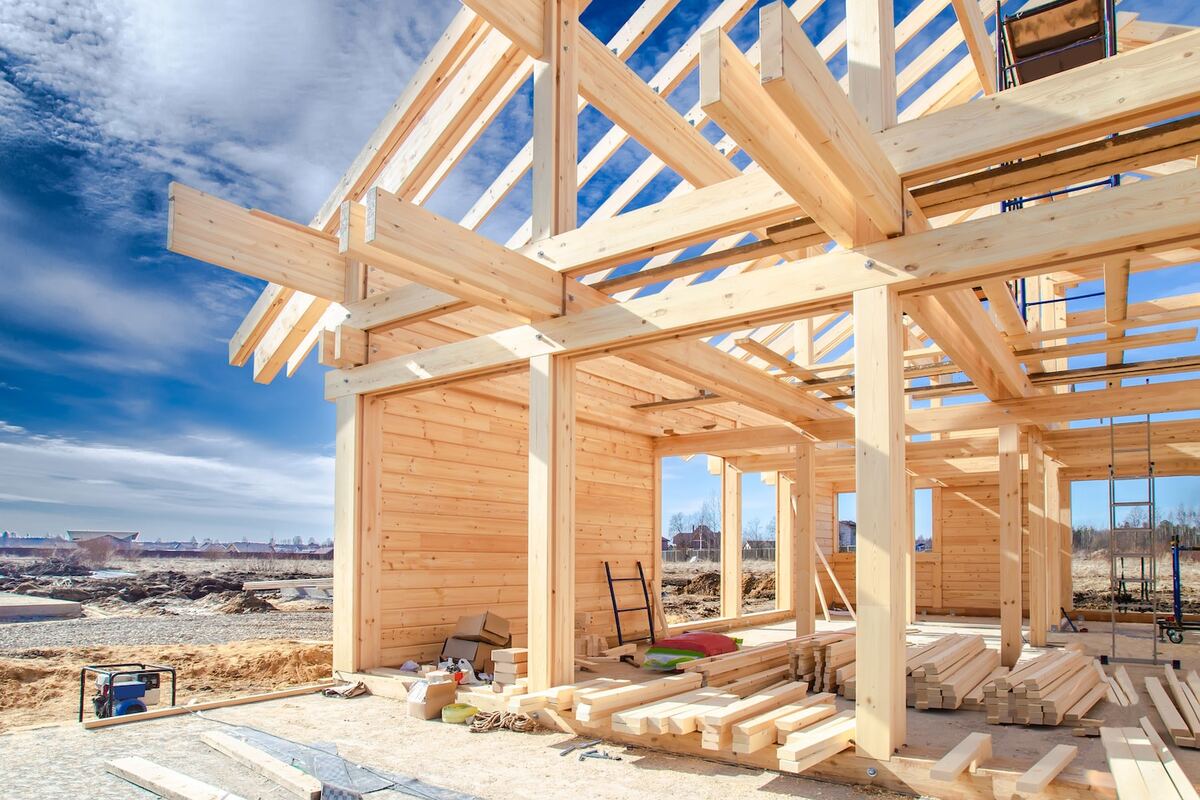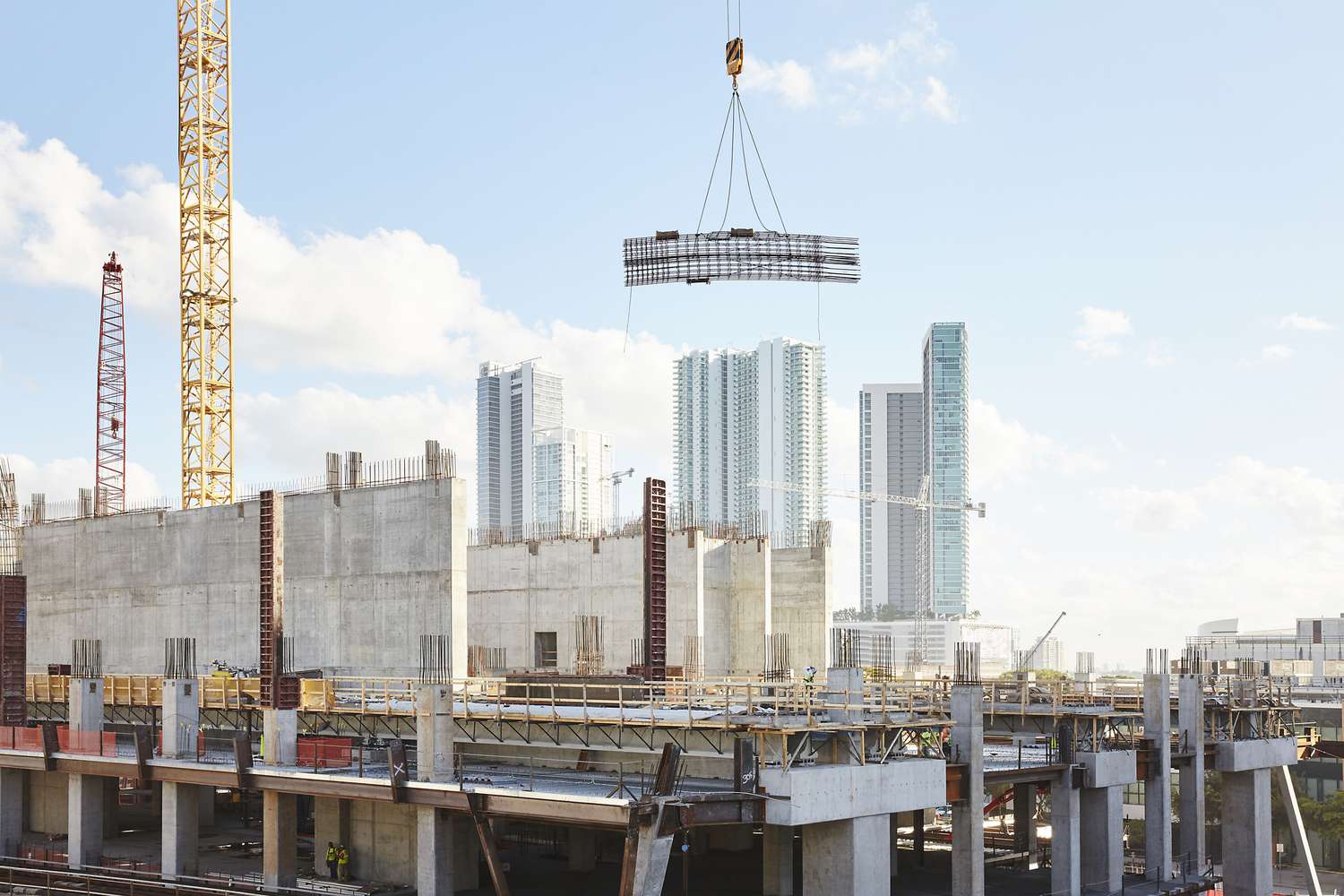Home>diy>Building & Construction>How To Get A Construction Loan For Remodeling


Building & Construction
How To Get A Construction Loan For Remodeling
Modified: October 20, 2024
Looking to remodel your home? Learn how to secure a construction loan for your building construction project and turn your renovation dreams into reality.
(Many of the links in this article redirect to a specific reviewed product. Your purchase of these products through affiliate links helps to generate commission for Storables.com, at no extra cost. Learn more)
Introduction
Welcome to the world of constructing and remodeling! Whether you are planning to build your dream home from scratch or give your existing property a much-needed upgrade, navigating the intricacies of construction loans is essential for a successful project. Understanding the ins and outs of construction loans can help you secure the necessary funding and make your remodeling dreams a reality.
Construction loans are specifically designed to finance the construction or renovation of a property. Unlike traditional home loans, where the funds are disbursed as a lump sum, construction loans are released in stages, known as drawdowns, as the construction progresses. This flexible financing option allows you to pay for the costs of labor, materials, and other construction-related expenses throughout the remodeling process.
One of the key advantages of a construction loan for remodeling is its ability to provide financing based on the future value of the property. This means that the loan amount can include not only the cost of the renovations but also the post-renovation value of the property. This can be particularly advantageous if you plan to add significant value to your home through your remodeling project.
Qualifying for a construction loan requires meeting certain criteria set by the lender. Key factors considered include your credit history, income stability, and the feasibility and value of the remodeling project. Planning and preparation are crucial to ensure a smooth loan application process, and choosing the right lender and loan terms can make all the difference in getting the funding you need.
In this comprehensive guide, we will take you through the steps involved in obtaining a construction loan for remodeling. We will explore the requirements, benefits, and potential challenges associated with construction loans. By the end, you will have a thorough understanding of the construction loan process and be better equipped to navigate the financial landscape of your remodeling project.
So, let’s dive in and learn how to get a construction loan for remodeling!
Key Takeaways:
- Construction loans offer flexible payments, funds for renovation costs, and consideration of future property value. They provide control, oversight, and potential tax benefits, making them a valuable resource for remodeling projects.
- Qualifying for a construction loan requires a strong credit history, stable income, and a feasible remodeling project. Choosing the right lender and preparing a comprehensive loan application are crucial steps in securing the necessary funding.
Read more: How To Get A Construction Loan For A Remodel
Understanding Construction Loans
Before diving into the process of obtaining a construction loan for remodeling, it’s important to have a clear understanding of what construction loans entail. Construction loans are short-term loans that provide the necessary funds to build or renovate a property. They are distinctly different from traditional home loans, and understanding their unique features is crucial.
One of the key differences between a construction loan and a conventional mortgage is the disbursement of funds. In a traditional mortgage, the lender disburses the entire loan amount upfront. However, with a construction loan, the funds are released in stages or drawdowns as the construction progresses. These drawdowns are typically made in predetermined increments and are closely tied to specific milestones or phases of the remodeling project.
Another important aspect of construction loans is that they often have higher interest rates compared to traditional mortgages. This is due to the higher risk involved in lending funds for a property that does not yet exist or is undergoing renovation. Construction loans are typically short-term, with a duration ranging from six months to two years. However, some lenders may offer extended terms, depending on the complexity and scope of the remodeling project.
Construction loans can be classified into two main types: construction-to-permanent loans and stand-alone construction loans. A construction-to-permanent loan, also known as a one-time close loan, combines the financing for both the construction phase and the permanent mortgage into a single loan. This type of loan allows for a seamless transition from the construction phase to homeownership once the project is complete.
On the other hand, stand-alone construction loans, also known as interim or construction-only loans, cover only the costs of construction. Once the remodeling project is finished, you will need to obtain a separate mortgage to pay off the construction loan. Stand-alone construction loans are typically a preferred choice for those who already own a property and are looking to renovate or extend their existing home.
Understanding the nuances of construction loans will help you determine which type of loan is best suited for your remodeling project. By choosing the right loan structure, you can ensure that you have the necessary funds to cover the construction or renovation costs, while also meeting your long-term homeownership goals.
Benefits of a Construction Loan for Remodeling
When it comes to financing your remodeling project, a construction loan offers several benefits that make it an attractive option. Understanding these benefits can help you make an informed decision and effectively leverage the advantages of a construction loan for your renovation needs.
1. Flexible Payments: Unlike traditional mortgages, where you are required to make monthly payments on the entire loan amount, construction loans allow for flexible payments based on the drawdowns. This means that you only pay interest on the portion of the loan that has been disbursed. As construction progresses and more drawdowns are made, your payments gradually increase. This flexibility can help manage your cash flow effectively during the remodeling process.
2. Funds for Renovation Costs: A construction loan provides funds specifically for the costs associated with remodeling or renovating a property. This includes expenses such as labor, materials, permits, and architectural or design fees. Having access to dedicated funds ensures that you can cover these expenses without affecting your personal savings or other financial commitments.
3. Future Property Value Consideration: One of the significant advantages of a construction loan for remodeling is that it factors in the post-renovation value of the property. The loan amount can be based not only on the current value of the property but also on the expected increase in value after the remodeling project is completed. This can provide you with additional funding to undertake more substantial renovations and potentially increase the overall value of your property.
4. Same Lender for Construction and Permanent Mortgage: If you opt for a construction-to-permanent loan, you have the convenience of working with the same lender for both the construction phase and the permanent mortgage. This eliminates the need to find a new lender once the construction is complete, saving you time and effort. Additionally, the transition from the construction loan to a permanent mortgage is seamless, simplifying the overall loan process.
5. Avoids Paying for Unused Construction Funds: With a construction loan, you only pay interest on the portion that has been drawn down. This means that you are not paying interest on any unused construction funds, which can help save on costs. Additionally, the lender typically assesses the value of the completed work at each drawdown stage, providing assurance that the funds are being used as intended.
6. Increased Control and Oversight: By obtaining a construction loan, you have greater control over the remodeling process. Unlike relying on personal savings or a traditional mortgage, where you have a limited budget, a construction loan allows you to closely monitor and manage the expenses throughout the project. This level of oversight ensures that the funds are allocated efficiently and helps prevent any overspending.
7. Potential Tax Benefits: Depending on your circumstances and location, there may be potential tax benefits associated with taking out a construction loan for remodeling. Consult with a tax professional to understand any tax deductions or credits that you may be eligible for, such as deductions on interest paid during the construction phase.
Considering these benefits, a construction loan can be a valuable resource, providing the necessary funding and flexibility to complete your remodeling project with ease. However, bear in mind that each individual’s financial situation is unique, and it’s essential to carefully evaluate these advantages based on your specific needs and goals.
Qualifying for a Construction Loan
Qualifying for a construction loan is an important step in securing the necessary funds for your remodeling project. Lenders have specific requirements that borrowers must meet to be eligible for a construction loan. Here are some key factors that lenders consider when evaluating loan applications:
1. Credit History: Your credit history plays a vital role in determining your eligibility for a construction loan. Lenders will review your credit score, payment history, and existing debts to assess your creditworthiness. A higher credit score generally increases your chances of qualifying for a construction loan and may result in more favorable loan terms.
2. Income and Debt-to-Income Ratio: Lenders will evaluate your income stability and debt-to-income (DTI) ratio to determine your ability to repay the loan. A lower DTI ratio, which represents the percentage of your monthly income dedicated to debt payments, is preferred. Providing proof of a stable income, such as pay stubs or tax returns, can help increase your chances of qualifying for a construction loan.
3. Down Payment: Construction loans typically require a down payment, which is a percentage of the total loan amount. The down payment amount may vary depending on factors such as your credit history, loan type, and lender requirements. Having a sizable down payment demonstrates your commitment to the project and reduces the lender’s risk, increasing your chances of loan approval.
4. Remodeling Project Feasibility: Lenders assess the feasibility of your remodeling project to ensure that it aligns with their lending criteria. They will review the project plans, cost estimates, and timelines to determine if the project is viable. Factors such as the increase in property value, the scope of renovations, and the overall market conditions will be considered.
5. Builder Qualifications: If you are working with a builder or contractor for your remodeling project, their qualifications and track record may also be evaluated by the lender. Lenders want to ensure that the builder has the necessary experience, licenses, and insurance to complete the project successfully. Providing information and documentation regarding the builder’s credentials can strengthen your loan application.
It’s important to note that each lender may have specific requirements and criteria for their construction loan programs. Before applying for a loan, it is advisable to consult with multiple lenders to understand their specific qualification criteria and find the best match for your needs.
Preparing and organizing your financial documents ahead of time is crucial to streamline the loan application process. Be prepared to provide supporting documents such as bank statements, tax returns, project plans, and cost estimates. Demonstrating your financial stability and the feasibility of your remodeling project will greatly enhance your chance of qualifying for a construction loan.
Steps to Obtain a Construction Loan
Obtaining a construction loan for your remodeling project requires careful planning and preparation. Following the necessary steps will increase your chances of securing the funding you need. Here are the key steps involved in obtaining a construction loan:
1. Define Your Remodeling Project: Clearly identify the scope of your remodeling project and determine your budget. Consider factors such as the type of renovations you want to undertake, the timeline you aim to complete the project within, and the estimated costs. Having a detailed plan will help you communicate your project requirements to the lender.
2. Research and Identify Potential Lenders: Conduct thorough research to identify lenders who specialize in construction loans. Speak with different lenders to understand their loan programs, interest rates, repayment terms, and requirements. Compare their offerings and choose a lender that best meets your needs.
3. Gather Financial Documents: Prepare all the necessary financial documents required for the loan application. This includes bank statements, tax returns, pay stubs, and any other documents that demonstrate your income stability and creditworthiness. Also, gather project-related documents such as detailed plans, cost estimates, and construction contracts.
4. Submit Loan Application: Fill out the loan application form provided by your chosen lender. Provide accurate and complete information about your personal and financial background, as well as the details of your remodeling project. Attach all the required supporting documents to strengthen your loan application.
5. Wait for Loan Approval: After submitting your loan application, the lender will review the application and the supporting documents. This process may take some time, so be patient. The lender may also conduct a property appraisal to assess its value and verify whether it aligns with your loan request.
6. Receive Loan Approval and Finalize Terms: If your loan application is approved, you will receive a formal loan approval letter. Review the terms and conditions of the loan carefully, including the interest rate, repayment schedule, and any associated fees. Seek clarification if needed and ensure that you fully understand the terms before proceeding.
7. Close the Loan: Once you have reviewed and agreed to the loan terms, you will proceed to the loan closing process. This involves signing the necessary documents and paying any applicable closing costs or fees. Take the time to carefully review and understand all the loan documents before signing them.
8. Start Your Remodeling Project: After the loan is closed, you will receive the necessary funds for the construction or renovation of your property. Work closely with your builder or contractor to ensure the project progresses according to plan. Keep in mind that the funds will be released in stages or drawdowns based on the agreed-upon milestones or completion of specific project phases.
Throughout the process of obtaining a construction loan, it’s essential to maintain open and clear communication with your lender. Stay proactive and provide any additional information or documentation they may require promptly. By following these steps and staying organized, you can navigate the loan application process effectively and move forward with your remodeling project.
Read more: How To Get A Construction Loan For A Home
Preparing Your Construction Loan Application
Preparing a well-organized and comprehensive construction loan application is crucial to increase your chances of approval. Lenders require specific documentation and information when evaluating loan applications. Here are some key steps to prepare your construction loan application:
1. Review Lender Requirements: Start by understanding the specific requirements of your chosen lender. Each lender may have different criteria and documentation needs, so carefully review their loan application guidelines. This will help you gather all the necessary documents and information required for a complete application.
2. Financial Documentation: Prepare your financial documents, including bank statements, tax returns, and pay stubs. These documents help lenders assess your income stability and ability to repay the loan. Be sure to include all relevant financial information from the past two to three years to provide a comprehensive view of your financial situation.
3. Project Plans and Estimates: Provide detailed project plans and cost estimates for your remodeling project. These plans should include architectural drawings, blueprints, and a breakdown of materials and labor costs. The more detailed and accurate your project plans and estimates are, the easier it will be for the lender to assess the feasibility of your project.
4. Builder or Contractor Information: If you are working with a builder or contractor for your remodeling project, provide their information and qualifications. This includes their licenses, insurance details, and any relevant certifications. The lender will evaluate the builder’s expertise and credibility to ensure the successful completion of the project.
5. Personal Identification and Credit Information: Include copies of your government-issued identification documents, such as a driver’s license or passport. Additionally, provide authorization for the lender to access your credit report. This allows them to evaluate your creditworthiness and payment history, which are crucial factors in the loan approval process.
6. Property Documentation: Gather all property-related documents, including past property appraisals, insurance policies, and any existing mortgage information. This provides lenders with a complete understanding of the property and its current value, which is important for determining the loan amount.
7. Loan Application Form: Complete the loan application form accurately and include all relevant information. Double-check the form for any errors or missing details before submitting it to the lender. Incomplete or incorrect information can delay the loan approval process or jeopardize your chances of approval.
8. Explanation of Special Circumstances: If you have any unique circumstances or special considerations, such as self-employment or irregular income, include a clear explanation with supporting documentation. Providing a thorough explanation helps lenders understand your situation and assess your loan application accordingly.
Organize all your documents and information in a logical and easily accessible manner. Label each document clearly and keep multiple copies for your own reference. By being prepared and presenting a well-prepared loan application, you demonstrate to the lender that you are a serious applicant, increasing the likelihood of loan approval.
When applying for a construction loan for remodeling, be prepared to provide detailed plans, cost estimates, and a timeline for the project. Lenders will want to see that you have a clear vision and realistic budget.
Choosing the Right Lender for Your Construction Loan
Choosing the right lender for your construction loan is crucial to ensure a smooth and successful financing experience. Not all lenders offer construction loans, and even among those who do, the terms and requirements can vary significantly. Here are some key factors to consider when selecting the right lender for your construction loan:
1. Expertise in Construction Loans: Look for lenders who specialize in construction loans or have extensive experience in financing remodeling projects. Construction loans have unique requirements and processes, so working with a lender who understands the intricacies of these loans can make a significant difference in the success of your project.
2. Reputation and Track Record: Research the reputation and track record of potential lenders. Read reviews, ask for recommendations from trusted sources, and check their financial stability. A reputable lender with a strong track record is more likely to provide reliable and efficient service throughout the construction loan process.
3. Loan Products and Terms: Evaluate the loan products and terms offered by different lenders. Consider factors such as interest rates, loan duration, repayment options, and any associated fees or closing costs. Compare these aspects among multiple lenders to find the loan terms that best suit your financial needs and goals.
4. Flexibility and Customization: Look for lenders who offer flexibility and customization options for your construction loan. Each remodeling project is unique, so having a lender who can tailor the loan to match your specific requirements can be highly advantageous. This includes the ability to adjust drawdown schedules, repayment plans, and other loan terms to accommodate your project’s timeline and budget.
5. Communication and Support: Evaluate the lender’s communication style and level of support. Clear and timely communication is essential throughout the loan process, from application to closing and beyond. Choose a lender who is responsive, transparent, and readily available to address any queries or concerns you may have.
6. Prequalification Process: Inquire about the lender’s prequalification process. A thorough prequalification process helps both you and the lender evaluate your eligibility and assess the feasibility of your remodeling project. A lender who conducts a comprehensive review of your financials and project plans demonstrates a commitment to ensuring a successful lending experience.
7. Customer Service: Assess the lender’s customer service quality. Pay attention to how they treat you during the initial interactions and whether they are willing to provide detailed explanations and guidance. A lender with excellent customer service will be committed to ensuring your satisfaction and helping you navigate the loan process smoothly.
8. Recommendations and References: Seek recommendations and references from friends, family, or industry professionals who have previously worked with construction loan lenders. Their firsthand experiences can provide valuable insights and help you make an informed decision.
Take your time to thoroughly research and compare different lenders before making a final decision. Consulting with multiple lenders and asking detailed questions will help you assess their expertise, responsiveness, and suitability for your specific needs. Choosing the right lender is essential in securing the financing you need to bring your remodeling project to fruition.
Evaluating Loan Options and Terms
When obtaining a construction loan for your remodeling project, it’s important to carefully evaluate the loan options and terms offered by different lenders. Each lender may have different loan products and terms, making it crucial to assess them to find the best fit for your financial needs. Here are key factors to consider when evaluating loan options and terms:
1. Interest Rates: Compare the interest rates offered by different lenders. Even a slight difference in interest rates can significantly impact the overall cost of your loan. Lower interest rates can result in reduced monthly payments and save you money over the life of the loan. However, be cautious of exceptionally low rates, as they may come with hidden fees or unfavorable terms.
2. Loan Duration: Consider the duration of the loan. Construction loans typically have a shorter term compared to traditional mortgages, usually ranging from six months to two years. Longer loan terms may offer more flexibility in repayment, but they can also result in more interest paid over time. Evaluate your project timeline and choose a loan duration that allows you to complete the remodeling project comfortably.
3. Repayment Options: Review the repayment options offered by lenders. Some lenders may offer interest-only payments during the construction phase, which can help manage immediate cash flow. Others may require principal and interest payments from the start. Understand the repayment structure and choose the option that aligns with your financial situation and preferences.
4. Drawdown Schedule: Examine the drawdown schedule for the loan. A drawdown schedule outlines when and how the funds will be disbursed throughout the construction process. Make sure the drawdown schedule aligns with your project timeline and cash flow needs. If possible, negotiate a flexible drawdown schedule that accommodates the progress of your remodeling project.
5. Fees and Closing Costs: Inquire about any fees and closing costs associated with the loan. Construction loans may come with various fees, including application fees, appraisal fees, and processing fees. Take into account these additional costs when evaluating loan options. Compare the fee structure among lenders to ensure you are not paying excessive fees.
6. Loan-to-Value Ratio (LTV): The loan-to-value ratio represents the percentage of the loan amount in relation to the appraised value of the property. A higher LTV indicates a higher loan amount in relation to the property value. Consider the LTV offered by different lenders and choose one that provides the funding you need without requiring excessively high equity in the property.
7. Prepayment Penalties: Determine if the loan has any prepayment penalties. Prepayment penalties are charges imposed when you pay off the loan before the agreed-upon term. If you anticipate the possibility of refinancing or paying off the loan early, look for lenders who do not impose prepayment penalties or offer flexible terms in this regard.
8. Customer Reviews and Reputation: Research customer reviews and assess the reputation of lenders. Online reviews and testimonials can provide insights into the experiences of other borrowers. Choose lenders with a positive reputation for excellent customer service, responsiveness, and transparency throughout the loan process.
While interest rates and loan terms are important considerations, it’s also crucial to evaluate the overall package offered by lenders. The best loan option is one that not only offers favorable interest rates and terms but also provides excellent customer service and a smooth loan process. Take the time to compare lenders, ask questions, and ensure that you fully understand the terms and conditions before committing to a construction loan.
Securing Funding for Your Remodeling Project
Securing funding for your remodeling project is a critical step in bringing your vision to life. While obtaining a construction loan is a popular choice, there are other funding options you can explore. Here are several avenues to consider when securing funding for your remodeling project:
1. Construction Loans: Construction loans are specifically designed to finance construction or renovation projects. They provide the necessary funds in stages, known as drawdowns, as the construction progresses. Construction loans offer flexibility and customized terms for your remodeling project. Research lenders specializing in construction loans, compare their terms, and choose the one that best suits your needs and financial situation.
2. Home Equity Loans: If you have accumulated equity in your property, you can consider a home equity loan. This type of loan allows you to borrow against the equity you have built in your home. Home equity loans typically offer lower interest rates than other forms of borrowing. However, keep in mind that the loan amount will depend on the value of your property and the amount of equity you have available.
3. Home Equity Line of Credit (HELOC): Similar to a home equity loan, a HELOC allows you to borrow against the equity in your property. However, a HELOC functions more like a credit card, where you have a revolving line of credit to draw upon as needed. This can be a useful funding option if you anticipate fluctuating cash needs during the remodeling project. Interest is only charged on the amount you borrow, making it a flexible financing solution.
4. Personal Savings: Utilizing personal savings is another option to fund your remodeling project. If you have savings set aside for this purpose, it can be a convenient and cost-effective way to finance your project. While using personal savings eliminates interest charges and loan repayment, it’s important to ensure that you have enough savings to cover both the construction costs and any unexpected expenses that may arise.
5. Credit Cards: Credit cards can be a source of funding for smaller remodeling projects or temporary cash flow needs. However, keep in mind that credit cards typically come with higher interest rates compared to other forms of financing. Using credit cards for larger remodeling projects may not be the most cost-effective option, especially if you cannot repay the balance quickly.
6. Partnerships or Investors: If you are open to sharing ownership or seeking investors, you may consider forming partnerships or seeking investors for your remodeling project. This option allows you to pool resources and share financial responsibility. However, it’s important to clearly define your agreements, expectations, and legal structures before entering into any partnerships or seeking investors.
7. Grants and Special Programs: Research grants and special programs that may be available for home remodeling projects. Some government agencies, nonprofit organizations, or local community programs offer financial assistance for specific types of renovations. Explore these options in your area to see if you qualify for any grant programs or specialized funding.
Consider your financial situation, the size and scope of your remodeling project, and your comfort with borrowing when deciding on the best funding option. It’s advisable to consult with financial experts, such as lenders or financial advisors, to help you evaluate the pros and cons of each funding avenue. By securing the right funding, you can confidently move forward with your remodeling project.
Read more: How To Get Church Construction Loans
Managing Your Construction Loan and Project
Managing your construction loan and project effectively is crucial to ensure a smooth and successful remodeling experience. Here are some key steps to help you manage your construction loan and project:
1. Stay Organized: Keep all loan-related documents, contractor agreements, and project plans organized and easily accessible. Create a dedicated folder or digital file where you can store everything related to your construction loan and project. This will help you stay on top of important information and easily locate documents when needed.
2. Communicate with Your Lender: Regularly communicate with your lender to stay informed about the loan disbursement process and any specific requirements or conditions associated with your loan. Maintain open lines of communication to address any questions or concerns promptly. Notify your lender in advance of any changes to the project scope or timeline that may impact the loan terms.
3. Coordinate with Your Contractor: Maintain regular communication with your contractor to ensure the project progresses smoothly. Provide the necessary documentation and information required by the lender for the loan drawdowns. Keep your contractor informed about loan disbursements, especially when planning for the next phase of construction. Regular updates and clear communication will help keep your project on track.
4. Monitor Construction Progress: Monitor the progress of your remodeling project closely. Regularly visit the site and communicate with your contractor to ensure that the work is progressing according to schedule and quality standards. Address any concerns or issues promptly to avoid delays or costly rework.
5. Keep Track of Expenses: Maintain a detailed record of all construction-related expenses. This includes invoices, receipts, and payment documentation. Knowing the exact costs incurred during the construction process will help you manage your budget effectively and track your overall spending. This documentation will also come in handy when reviewing loan terms and potentially claiming tax deductions.
6. Monitor Loan Drawdowns: Stay aware of the loan drawdowns and ensure they align with the project milestones or completion of specific construction phases. Coordinate with your lender and contractor to ensure that the loan funds are released in a timely manner to cover the necessary expenses. Keep accurate records of the loan drawdowns for future reference.
7. Manage Cash Flow: Construction projects can involve fluctuating cash flow needs. Ensure that you have a cash flow plan in place to manage all construction-related expenses, including payments to contractors and suppliers. Consider setting up a separate account solely for project-related transactions to easily track and manage your cash flow throughout the construction process.
8. Address Changes or Challenges: As with any construction project, there may be changes, unexpected challenges, or additional expenses that arise along the way. Communicate any changes or challenges promptly with your lender and contractor. Work collaboratively to determine the best course of action and address any necessary adjustments to the loan terms or construction plans.
9. Monitor Loan Repayment: Stay on top of your loan repayment obligations. Set reminders and establish a system to ensure that your loan payments are made on time. Prompt repayment helps maintain a good relationship with your lender and positively impacts your creditworthiness.
10. Keep Records for Tax Purposes: Maintain thorough records of your construction loan and project expenses for tax purposes. Consult with a tax professional to understand any tax deductions or credits that may be applicable to your particular situation. Keep all necessary documentation for tax filings and be proactive in claiming any eligible deductions.
By effectively managing your construction loan and project, you can ensure a smooth and successful remodeling experience. Clear communication, organizational skills, and diligent follow-up will help you navigate the loan process and oversee the construction project effectively.
Potential Challenges and How to Overcome Them
While a construction loan for your remodeling project can be a valuable tool, it’s important to be aware of potential challenges that may arise during the process. By understanding these challenges and knowing how to overcome them, you can navigate your remodeling project with confidence. Here are some common challenges and strategies to overcome them:
1. Delays in Construction: Construction projects often encounter unexpected delays due to various factors, such as weather conditions, supply chain disruptions, or unforeseen complications. To mitigate delays, work closely with your contractor to establish a realistic timeline and build in flexibility for potential setbacks. Regular communication and proactive planning can help address any delays promptly and minimize their impact on the project.
2. Cost Overruns: Remodeling projects are notorious for exceeding initial cost estimates. Unexpected expenses or changes in project scope can lead to cost overruns. To avoid this, conduct thorough research and obtain detailed cost estimates before starting the project. Build contingency funds into your budget to account for unforeseen expenses. Regularly review and track your project expenses to stay within budget and make informed decisions when faced with additional costs.
3. Communication Challenges: Effective communication is essential for the success of your project. Miscommunications or misunderstandings between you, the lender, and the contractor can lead to confusion and delays. Establish clear channels of communication and ensure that all parties are aligned on project requirements, timelines, and milestones. Regularly schedule meetings or check-ins with the lender and contractor to keep everyone informed and address any issues promptly.
4. Changes to Project Scope: It’s common for remodeling projects to undergo changes in scope as the work progresses. However, changes can lead to additional costs and delays. Before making any changes, carefully assess the impact on the project timeline, budget, and loan terms. Communicate changes to your lender and contractor to ensure that they are properly documented and accounted for in the construction loan and project plan.
5. Financing Difficulties: Securing adequate financing can be a challenge, especially if your financial situation changes during the remodeling project. Unexpected changes in income, credit, or property value may affect your ability to secure financing. To overcome this, maintain open communication with your lender throughout the project. Keep them informed of any changes and work together to explore alternative solutions or financing options.
6. Code Compliance and Permits: Remodeling projects often require building permits and compliance with local building codes. Delays or challenges in obtaining permits can impact the construction timeline. Before starting the project, research and familiarize yourself with the necessary permits and regulations. Work closely with your contractor to ensure that all required permits are obtained and that the project meets all code requirements.
7. Disputes with Contractors: Disputes with contractors can arise during remodeling projects, leading to strained relationships and potential legal issues. To mitigate this risk, carefully vet contractors before hiring them. Research their reputation, review contracts thoroughly, and clearly define project expectations and deliverables. Maintain open and transparent communication throughout the project to address any concerns or disagreements promptly.
8. Lack of Construction Experience: If you have limited experience with construction projects, it can be challenging to navigate the complexities of a remodeling project. Educate yourself about construction processes, terminology, and best practices. Consult with experts, such as architects, engineers, or construction consultants, to gain valuable insights and guidance. Building a team of knowledgeable professionals can help you overcome challenges and make informed decisions throughout the project.
By being prepared for potential challenges and implementing strategies to overcome them, you can navigate your remodeling project more effectively. Flexibility, proactive communication, and careful planning are key to successfully managing any challenges that may arise during the construction loan process.
Conclusion
Congratulations on reaching the end of this comprehensive guide on obtaining a construction loan for your remodeling project! By understanding the nuances of construction loans, evaluating loan options and terms, and managing potential challenges, you are well-equipped to embark on your remodeling journey with confidence.
Securing the right financing is crucial in transforming your vision into reality. Whether you choose a construction loan, home equity loan, or other funding options, carefully evaluate the terms, interest rates, and repayment options to ensure they align with your financial goals and project timeline.
Throughout the loan process, communication is key. Openly communicate with your lender to understand their requirements and keep them updated on any changes or challenges faced during the project. Likewise, maintaining a strong line of communication with your contractor will help ensure that your vision is properly understood and executed.
Managing your construction loan and project requires organization, diligent tracking of expenses, and regular site visits to monitor progress. Stay proactive in addressing potential delays or cost overruns, and be prepared to make informed decisions when faced with project scope changes or unexpected challenges.
Remember that your construction loan is just one part of the equation. Building a team of experienced professionals, such as architects, contractors, and financial advisors, can provide valuable guidance and support throughout the process.
Lastly, always stay informed and up-to-date on local building codes, permits, and regulations. Compliance with these requirements is essential in ensuring a smooth project progression and avoiding any legal complications down the line.
By leveraging the knowledge and insights gained from this guide, you are now equipped with the tools necessary to obtain a construction loan for your remodeling project. Take these principles and apply them to your specific circumstances to secure the funding you need and bring your remodeling dreams to life.
Good luck with your remodeling project, and may it be a rewarding and transformative journey!
Frequently Asked Questions about How To Get A Construction Loan For Remodeling
Was this page helpful?
At Storables.com, we guarantee accurate and reliable information. Our content, validated by Expert Board Contributors, is crafted following stringent Editorial Policies. We're committed to providing you with well-researched, expert-backed insights for all your informational needs.














0 thoughts on “How To Get A Construction Loan For Remodeling”